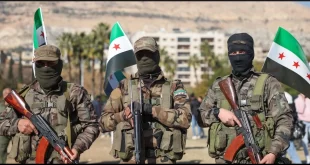by Hasan Ilaik, published on The Cradle, October 18, 2023
As wholly expected, and in line with decades of its foreign policy, Washington has thrown its full weight behind “standing with Israel” and its genocidal onslaught on Gaza. But while the two allies’ public stances line up prettily at this stage of the conflict, their views diverge on what comes next – specifically over the elimination of Hamas and other Palestinian resistance groups in Gaza.
The devastating impact of Operation Al-Aqsa Flood on the occupation state has presented an opportunity for the US and Israel to permanently eradicate the threat posed by the Palestinian resistance.
As the resistance’s unprecedented political, military, and psychological gains began to sink in, Washington immediately jumped into the fray:
For starters, the US dispatched an aircraft carrier to the Eastern Mediterranean – with another on its way – and has mobilized British and Italian warships in those waters in a show of support for Israel.
US Secretary of State Antony Blinken is playing a pivotal role in coordinating with Israel, openly participating in its cabinet meetings, and fronting diplomatic negotiations on behalf of Tel Aviv.
Simultaneously, US Secretary of Defense Lloyd Austin has arrived in Israel to provide his “unwavering” support, which includes the deployment of 2,000 US Special Forces troops to the Occupation state. The US military’s Central Command (CENTCOM) commander is also set to visit the border with Lebanon in the coming days.
And then tomorrow, the US president himself will arrive in Amman, Jordan, from where Joe Biden will travel to Jerusalem – the Israeli “capital city” that neither nations nor international law recognizes – to demonstrate the his country’s substantial support for Israel.
Warnings to the Resistance
These actions leave little doubt that it is Washington taking the lead in this war, not Israel’s Prime Minister Benjamin Netanyahu, his defense minister, or his chief of staff. Tel Aviv isn’t remotely trying to conceal this fact either. As prominent Israeli journalist Yossi Yehoshua stated, “the United States has complete control over the battle in Gaza.”
Because, truth be told, after the Hamas-led Al-Aqsa Flood, nobody has a whole lot of confidence in Israel’s military, which took the brunt of the resistance’s blow. This meant that the world’s preeminent naval power needed to be summoned to confront an armed group from the 365 square kilometer virtual cage that is Gaza.
In its essence, this is a standoff between Israel, the US and its NATO allies, and the Palestinian people of the Gaza Strip, which has endured a relentless, brutal siege for 18 years.
But Washington’s military build-up is not intended for a confrontation with Gaza. The introduction of US naval fleets into the Eastern Mediterranean has been orchestrated to deliver a deterrence message to Palestine’s resistance ally Hezbollah in Lebanon.
With good reason, the Americans view Hezbollah as “the world’s most heavily armed non-state actor.” They also quite correctly believe that the Lebanese resistance’s intervention in the war on Gaza will alter its course and potentially prevent Israel from achieving its objectives.
Although no credible source can confirm the exact number of Hezbollah’s missile arsenal, regional and western analysts estimate the number to be as high as 130,000 missiles – possibly more – most of which are unguided. But Hezbollah Secretary-General, Hassan Nasrallah, confirmed in a televised statement aired on February 2022 that Hezbollah can convert rockets into precision missiles, and is fully capable of producing drones. A year prior, Nasrallah also confirmed that his party was now 100,000 men strong – with all missiles aimed toward Israel.
When Hezbollah did not respond to the warnings Washington sent via multiple Lebanese, Arab, and UN channels, the Americans decided to get more explicit: Threats were made to the group and its allies that Hezbollah’s entry into the war would lead to Lebanon’s destruction. Similar threats were also delivered to Iraq’s many resistance organizations.
Syrian President Bashar al-Assad received a more unique warning – that if he allowed a Syrian front to be opened against Israel, he would personally suffer the consequences. This, while Israel was bombing Syria’s international airports in Damascus and Aleppo.
Delaying the Gaza ground invasion
The Southern Lebanese Front has been active since 8 October. Hezbollah, adamant that it won’t remain on the sidelines, has been launching frequent attacks on Israeli positions in the occupied Sheba Farms and along the Lebanese-Palestinian border.
The group has inflicted casualties on the Israeli army in response to the deaths of Hezbollah fighters, journalists, and Lebanese civilians. Alongside Hezbollah are their Palestinian allies in Lebanon, Hamas and Palestinian Islamic Jihad (PIJ), who have been engaging in cross-border operations in recent weeks.
In Gaza, the occupation army continues its systematic destruction of civilian neighborhoods, so far dropping more than 6,000 bombs weighing a total of 4,000 tons. Despite Israel’s carpet-bombing of the Gaza Strip, Hamas reports that its military capabilities remain fully intact.
In the meantime, the Israeli military has mustered a force of approximately 140,000 troops for the now-delayed ground invasion of densely populated Gaza, home to over two million civilians. Israel’s aggression have already claimed more than 2,600 lives, with a significant majority – over 60 percent – being women and children.
Initially, the ground offensive was scheduled to commence on Friday, 13 October, but was postponed citing adverse weather conditions. According to the Jerusalem Post, however, the delay is actually due to “growing concern that Hezbollah is waiting for the moment that most IDF ground forces are committed to Gaza to open a full front with the IDF in the north.”
The Iran-led, regional Axis of Resistance calculates that the Israeli ground offensive is a “real possibility.” Iranian Foreign Minister Hossein Amir-Abdollahian has now issued a warning that continued Israeli aggression against Gaza could prompt the resistance to launch a preemptive strike against Israel “in the coming hours.”
Displacement or de-facto rule
In a flurry of diplomatic activity over the past few days, Abdollahian has visited Baghdad, Beirut, Damascus, and Doha, with Gaza high on his agenda. In meetings with Hezbollah Secretary General Hassan Nasrallah and the leadership of PIJ and Hamas, Iran’s top diplomat warned that Israel’s continued aggressions against Gaza may imminently escalate the conflict. The Resistance Axis, it appears, has already taken the decision to do everything possible to protect both the Palestinian resistance’s capabilities, and another Nakba.
Elsewhere, a complex debate has arisen among the US, Israel, Saudi Arabia, Jordan, and Egypt on the future of the Gaza Strip “after the elimination of Hamas.” Washington intends to use the bombing of Gaza to restructure Palestinian politics and society toward consolidating normalization agreements with Israel.
According to diplomatic sources, the Biden administration plans to leverage the ongoing conflict to dismantle the resistance in Gaza and transfer control of the Gaza Strip to the corrupt and US-compliant Palestinian Authority (PA). This strategy is seen as a step toward reviving the Saudi-Israeli normalization path, which took a nosedive after Operation Al Aqsa Flood.
Israel’s current leadership, however, is reluctant to bolster the PA to the extent the US wants; more than anything, Tel Aviv wants to displace Gaza’s Palestinian population outright. Israel’s essentially ethnic-cleansing plan, of course, faces opposition from Jordan and Egypt for entirely cynical reasons that include its economic, security, and demographic fallout – especially in Jordan, where the resettlement of Palestinians is a social and political tinderbox.
These divergent goals between the US and Israel are not rooted in the origins of the conflict. Despite overtly backing Israel and its exclusive “right to defend itself,” Biden has expressed his desire for a resolution and has issued a warning against Israel’s occupation of Gaza.
His warning essentially rejects any Israeli reoccupation of Gaza after the ground war’s objectives have been met. Interestingly, Biden has not issued a warning against the ground offensive itself – though the US is actively working to influence its direction behind the scenes. Publicly, the US is engaged in image enhancement tomfoolery by touting its support for humanitarian aid provisions set to enter Gaza from Egypt.
Region-wide implications
Three potential scenarios can be outlined for the next phase of this confrontation:
First, the US may respond to warnings from the Axis of Resistance, and either reduce in scope or altogether scrap Israel’s ground operation in Gaza.
Second, occupation forces may launch their ground invasion, with the specific objective of eliminating Hamas. This, of course, would be a formidable undertaking, even with the involvement of the US naval fleet. With more than 50,000 fighters present in Gaza today, the Israelis would encounter fierce resistance.
Such a battle is unlikely to conclude swiftly and could extend for months, during which the resistance will aim to make the cost of the ground war unbearable for Israel. Furthermore, the extensive focus on the Lebanese border may offer opportunities for Hezbollah to expand its operations and potentially intensify the conflict.
If the US follows through on its threat to confront Hezbollah, this could pave the way for the group’s regional allies to target US military assets in nearby countries like Iraq which could flip the conflict into a regional war.
Third, Saudi Arabia, in alignment with Washington, could propose a “peaceful solution” that effectively results in the surrender of the resistance in Gaza, an exchange of Israeli prisoners for the release of Palestinian prisoners in Israeli custody, and the return of the PA and its institutions, to the Gaza Strip.
According to Arab diplomatic sources, this proposal could allow Israel to achieve its objectives without resorting to a ground invasion. Saudi Arabia aims to bolster its image as the savior of the Palestinian people and has pledged to assist in the reconstruction of whatever Israel has destroyed.
Egyptian President Abdel Fattah al-Sisi has called for an international summit on Saturday, involving the US, Russia, China, Turkiye, the EU, the Persian Gulf states, Jordan, and the PA. The level of coordination between Saudi Arabia and Egypt in this matter is still uncertain, as both countries support the PA and may be working on side arrangements to normalize relations between Arab states and Israel.
In the days to come, diplomatic discussions will play a crucial role in determining the direction of the military theater. The key question at hand is whether Israel can be deterred from escalating the war, or whether the US will provide the necessary support for a large-scale offensive against the Palestinian population in Gaza, laying the groundwork for a broader regional conflict.
As Gaza’s regional allies have emphatically stated, the Palestinian people are not fighting this existential battle for survival and national liberation alone.
 Syria Support Movement solidarity with the Syrian people
Syria Support Movement solidarity with the Syrian people





